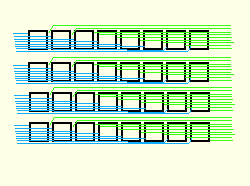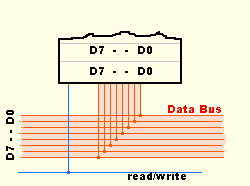Addressing


If we look at just a tiny section of such an array, we can see how quickly it becomes impossible to follow the individual wiring.
If these switches latch the voltages applied to their inputs, then, by signalling to the switches whether to read the voltages being applied to them or to output the voltages which it already has latched, we could combine the 'INPUTS' and the 'OUTPUTS' and form a single Data Bus. Depending on the read/write signal, we could either read volatges from the Data Bus as inputs or place voltages onto the Data Bus as outputs.
By convention, the right-most 'bit' is called 'D0', the next 'D1' and so on through to 'D7' (if we consider an 8-bit switch as an example). These correspond exactly with the decimal 'weightings' 1, 2, 4, 8, 16, 32, 64 and 128 we have seen previously.